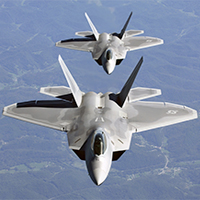F-22 pilot reaches 1,000 flight hours

Four-year-old Steve Rainey sat on the hood of his father’s car at a local airshow watching the small airplanes and helicopters at the airport. When the Thunderbirds in their F-100s sped by, Rainey fell off the car, looked up at the sky and thought, “I’ve got to do that.”
Jan. 22, the now chief test pilot flew his 1,000th hour in an F-22 Raptor. Rainey is the second person at Edwards to log 1,000 hours in the Raptor. He flew his milestone flight in tail number 4132, the flight sciences aircraft. When he landed, he was greeted by his wife and the entire F-22 Combined Test Force who were waiting to hose him down – a tradition for such occasions.
“All my life I wanted to fly,” said Rainey.
Even as a toddler, Rainey remembers watching Alan Shepard’s Mercury Redstone rocket launch at his grandmother’s house.
“My mother told me this was an important historical event and I was immediately hooked on aerospace and being a pilot.”
Rainey had been given opportunities to ride in airplanes as a child, but was finally able to start logging his own hours after joining the Air Force. He graduated from the Air Force Academy in 1980 and later graduated the U.S. Navy Test Pilot School as an Air Force exchange officer.
From there, Rainey was stationed at Edwards AFB where he flew F-4s and F-16s. After flying at historic Test Operations for six months he was made a flight commander at the F-16 Combined Test Force.
At the time, Lockheed Martin, Boeing and General Dynamics had secured a contract to design and build the advanced tactical fighter that is now the F-22. Rainey was assigned as the F-22 Test Program Manager at Wright Patterson AFB, Ohio, for the years leading up to critical design review. In 1996 he was assigned as the first F-22 Combined Test Force (411th Flight Test Squadron) operations officer, and when the time came to fly, he was scheduled for the third flight out of Lockheed Martin Marietta, Ga.
The first flight was flawless, but during the second the instrumentation system failed. Several structural modifications would have to be done before serious flight test could be conducted at Edwards. In September 1997 the decision was made to complete the required structural modifications and ship the first F-22 to Edwards.
“We brought the airplane out here on a C-5,” said Rainey. “It came in a bunch of boxes, literally. Little note, ‘some assembly required.'”
They rebuilt Ship One, performed all the ground tests and on May 17, 1998, Rainey flew the first flight at Edwards AFB.
“I was the first Air Force pilot to fly the airplane in ’98 and flew the first flight here, which was the third flight of the airplane.”
After serving as the 411th Flight Test Squadron commander, Rainey retired from the Air Force in 2000 and spent the next three years flying for commercial airlines.
Towards the end of his airline days, Rainey remembers sitting at the end of a runway in Albuquerque, N.M., that was shared with Kirtland Air Force Base. A four-ship formation of F-16s was cleared on to the runway ahead of them and Rainey missed the radio call that cleared the airliner to hold.
His captain told him as they prepared to climb, ‘you look like you lost your best friend.’
Within a week, he heard that Edwards was looking for civilian F-16 pilots. Rainey got the job and about two years after that was hired as the F-22 test pilot for Boeing.
“I was back home at the CTF,” said Rainey. “I was there to help finish up the Engineering, Manufacturing and Development phase and see it go operational, so that was really cool.”
Rainey was Boeing’s F-22 test pilot until January 2014 when Lockheed Martin hired him to be the F-22 chief test pilot.
“I’ve been very fortunate and I’ve been very lucky,” said Rainey. “I love what I do and I never want to stop doing it.”
Rainey views the F-22 as absolutely incredible and totally revolutionary.
Read More http://www.edwards.af.mil